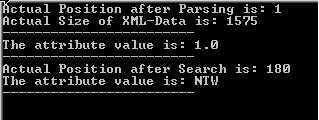MiniRobotLanguage (MRL)
XML.Attrib Value by Name
XML.avbn
Get an attributes value by specifying the attributes name
Intention
This command is used to retrieve an attributes value from an XML-Data Tag.
For this you have to set the current position to the Tag that has these attributes, that you want. Then you can use this command.
Here is an example for an XML-Tag with two attributes.
<Product ProductName="STATION 10" Name="Value">
This Tag has two attributes:
Number 1:
ProductName="STATION 10"
and Number 2:
Name="Value"
You could retrieve these attributes values using
XML.avbn|productname|$$RES
to get the value of Attribute Nr.1 into $$RES
or
XML.avbn|&EXACT:Name|$$RES
to get the value of Attribute Nr.2 into $$RES
As you can use "Parts of a Name" to specify the name of the attribute, simply writing "Name" would possibly bring you the value of the first attribute instead of the second.
You can and need to use 3.2 Standard-Search Pattern to specify the name of the attribute that you want. For example, you can use:
XML.avbn|{Pro&NDTHEN:Name}&OR:PName|$$RES
to specify a Name of an attribute. This way you can also specify alternative names,
for example if you have to analyze different languages.
Syntax
XML.avbn|P2[|P3][|P4]
Parameter Explanation
P2 - Variable with the name of the attribute that should be retrieved.
You can and need to use 3.2 Standard-Search Pattern to specify the name
of the attribute that you want.
P3 - (optional) Variable to return the result. The result is "" in case
no such attribute was found. If P3 was omitted the result is placed on TOS.
P4 - (optional) Count. In case there are multiple variables with the same name, you
can specify the number of the attribute that you want. If omitted "1" is the
default number.
Example
'***********************************
'
'***********************************
'Prototype für IML.
$$XMF=?pfad\Small_XML.txt
NEF.$$XMF
MBX.File $$XMF was not found!
GTO.enx
EIF.
' Now we are going to parse it
XML.Load File|$$XMF
' We check if there are errors
JIT.Lab_Err
' We get the "actual position" - after parsing.
XML.get pos|$$POS
PRT.Actual Position after Parsing is: $$POS
XML.get len|$$LEN
PRT.Actual Size of XML-Data is: $$LEN
'Here we start
PRT.------------------------
XML.avbn|ver|$$ERG
PRT.The attribute value is: $$ERG
PRT.------------------------
XML.sdn|{&EXACT:Product}
XML.get pos|$$POS
PRT.Actual Position after Search is: $$POS
XML.avbn|Sha|$$ERG
PRT.The attribute value is: $$ERG
PRT.------------------------
MBX.!
:enx
ENR.
'-----------------------------------------------------------
' Error Handler
:Lab_Err
XML.get error|$$ERT
DBP.$$ERT
ENR.
ENR.
This is the result of the sample script:

Here is the important part of the used XML-Data that is analyzed here:
<?xml version="1.0" encoding="UTF-8"?>
<!-- comment attrib="Hall"-->
<PatchInformation XMLVersion="1.0000.0000.4918" XMLLastUpdated="1/30/2010" PatchCount="1261">
<Products>
<Product ProductName="WINDOWS NT 4.0" SName="NTW">
You can find the XML-Sample-Data file in the Installation folder in the Samples-Folder "XML".
Remarks
-
Limitations:
-
See also:
• ! Smart Package Robot 's XML-Features
• XML. - eXtended Markup Language